Introduction
Parkinson’s disease is a progressive brain disorder that affects movement and is the second most common after Alzheimer’s. It affects approximately 1 in 1000 people, with a higher prevalence in those over 65 years. The condition is characterized by four cardinal signs: TRAP: tremors, rigidity, akinesia (loss of ability to move your muscles voluntarily), and postural disturbances.
In Ayurveda, it is viewed as Kampavata, a disease manifested primarily due to Vata Dosha Imbalance. Parkinson’s disease treatment in the Ayurvedic system focuses on balancing disturbed Vata dosha, addressing tissue degeneration and channel obstruction, using herbs, implementing specialized panchakarma procedures, and providing lifestyle and dietary modifications. Even though there is no cure for Parkinson’s disease in Ayurveda, In this blog, we will discuss certain effective therapies to manage the symptoms and improve quality of life.
Cure for Parkinson’s disease in Ayurveda
Ayurveda views Parkinson’s disease through stages, including early, progressive, advanced, and final stages. The early stage involves tremors that create discomfort in daily activities, while the progressive stage affects tendons and muscles, causing cramps and rigidity. The advanced stage is marked by poor balance, increased stiffness and giddiness while standing. The final stage symptoms include widespread tremors and potential bed or wheelchair-boundness.
Ayurveda therapies may provide a cure in the initial stage of the disease, while in the later stage, treatment modalities can prevent disease progression and improve quality of life with the help of physical rehabilitation.

Ayurveda for Parkinson’s Disease
Kampavata is difficult to cure due to its underlying pathologies. The treatment depends on the patient’s condition, chronicity of the disease, and ability of the patient to withstand the treatment procedures. In Dhatukshayajanya Kampavata (late-stage Parkinson’s), weakening and reduction in the function of the nervous system occurs. This stage is well managed with Vasti (therapeutic enema), Shirodhara (pouring medicated oil over the forehead), Shirovasti (Retention of medicated oil over the head), Nasya (instilling oil in nostril), etc modalities based on patients’ capacity to withstand the treatments. Emotional support is also provided by prescribing meditation and counseling.
Therapies beneficial in Parkinson’s disease
Abhyantara and Bahya Snehana – The most important Upakrama (supporting treatment) for kampavata is internal and external oleation, which involves having the patient ingest pure cow’s ghee or medicated ghee for certain days after assessing the patient’s condition. Following this, the patient is given 6-14 days of Bahya Snehana (external oleation) in the form of Shirodhara (Continuous Stream of Medicated oil on the Forehead), and Abhyanga (Oil Therapy).
Parkinson’s patients experience fewer muscle spasms and tremors plus better sleep quality when they receive Abhyanga treatment. Oil therapy helps blood flow better and relax muscles according to research which shows better daily performance and reduced movement problems.
Swedana (fomentation) – After achieving proper oil treatment the patient receives Patra Pinda Sweda and Shashtika Shali Pinda Sweda fomentation along with Kaya seka (oil pouring) to ease muscle stiffness. Fomentation can reduce muscle stiffness and improve mobility, and flexibility, reduce pain, and improve blood circulation, with studies suggesting optimal effect when fomentation is combined with exercises.
Virechana (therapeutic purgation) – It is a pradhanakarma (main therapy) that effectively eliminates both Vata and Pitta doshas if properly administered. This therapy involves the administration of a gentle purgative after the patient is properly prepared with internal oleation for several days prior. After purgation, patients should observe a prescribed light dietary regimen for four to seven days before resuming the normal diet. Doctors use this treatment on patients under 60 who tolerate purging and have Margavarodha. Research shows that this treatment helps fight oxidative stress while removing harmful substances linked to brain cell damage.
Vasti (Medicated Enema) – Vasti treatment focuses on balancing Vata Dosha which is out of control in Parkinson’s patients. The treatment helps control tremors while enhancing movement and treating constipation which affects many Parkinson’s patients. It helps fight oxidative stress while enhancing nutrient and medicine uptake.
Nasya (Instilling medicated oil to nostrils) – This involves delivering medicated oils through the nasal passages. Ayurveda considers the nose as a direct pathway to the brain. The oils are administered in specific quantities and at particular times of day. This therapy is believed to improve cognitive function, reduce tremors, and help with speech difficulties that Parkinson’s patients often experience.
Shiro Vasti and Shirodhara – Shiro Vasti involves retaining warm medicated oil on the scalp for a specific duration using a specially designed cap. Shirodhara consists of continuously pouring warm medicated oil or liquid over the forehead. Both treatments aim to calm the mind, improve sleep quality, and help control tremors.
Rasayana Chikitsa (Rejuvenation Therapy) – It is a comprehensive approach that is focused on the renewal of the body as well as the mind. It includes dietary protocols, lifestyle modifications, internal medicines, daily routine, and stress-management techniques, to improve body strength. Quality of life is enhanced by this approach, which is meant to slow the progression of the disease, thereby enhancing the natural healing energies of the body. It is performed after detoxification and is usually personalized depending on the symptoms presented by the patient and the constitution. together depending on the presentation of the patient, potential strength, and the stage of the disease. These therapies are usually combined and administered in a specific sequence based on the patient’s condition, strength, and stage of the disease.
Apollo AyurVAID Approach
Apollo AyurVAID provides complete Parkinson’s disease care that helps patients feel better while keeping their condition under control and living better. The process includes complete health checks, tests of motor skills, function studies of the nervous system, and blood tests along with MRI, etc scans. Expert Ayurveda doctors use proven treatment plans along with dietary adjustments to bring patients back to balance and improve their health while minimizing side effects from regular medications.

Conclusion
In the management of Parkinson’s disease, Ayurveda heals by addressing the imbalance of Vata dosha as well as the different stages of the condition. Several therapeutic procedures are applied in the management of the disease including Abhyanga, Swedana, Virechana, Vasti, Nasya, and Shirodhara, along with Rasayana. Appropriate dosage is determined according to the condition of the individual, the age of the person, and the strength of the person to withstand the therapy. However, these treatments should be conducted under the proper supervision of an Ayurveda physician. Although Ayurveda cannot completely heal an advanced case, combining specific therapeutic procedures, dietary management, and lifestyle modifications has been suggested for slowing the course of the diseases and shows great potential ways of managing symptoms and improving the capacity and quality of life.
References
- Menon, N. M., Adiga, M., & Pady, A. E. (2021). Understanding Parkinson’s Disease (PD) in Ayurvedic Perspective. International Journal of Ayurveda and Pharma Research, 9(6), 86-92. https://doi.org/10.47070/ijapr.v9i6.1944
- Sreenivas, S., Muralidhara, & Sindhura, A. S. (2019). The Purview of Parkinsonism in Ayurveda. Journal of Ayurveda Integrative Medicine Sciences, 5, 249-254. https://doi.org/10.21760/jaims.v4i05.730
- Raicha, K K, Thakar, A (2024). Management of Parkinson’s Disease (Kampavata) Through Panchakarma. International Journal of Ayurveda and Pharma Research. https://doi.org/10.47070/ijapr.v12i6.3248
- K, V et al. (2022). Effect of Musthadi Rajayapana Vasti in Parkinson’s Disease. International Journal of Ayurveda and Pharma Research. https://doi.org/10.47070/ijapr.
v10isuppl2.2516 - Dey, T et al. (2022). An Insight into the Conventional and Ayurvedic Therapies for the Treatment of Parkinson’s Disease. JOURNAL OF CLINICAL AND DIAGNOSTIC RESEARCH. https://doi.org/10.7860/jcdr/2022/
51177.15883






